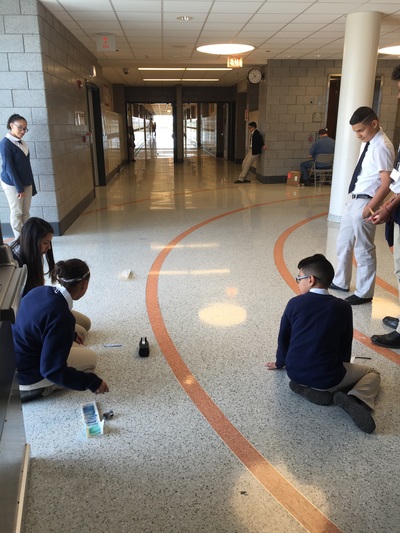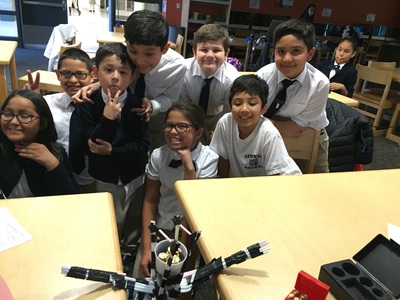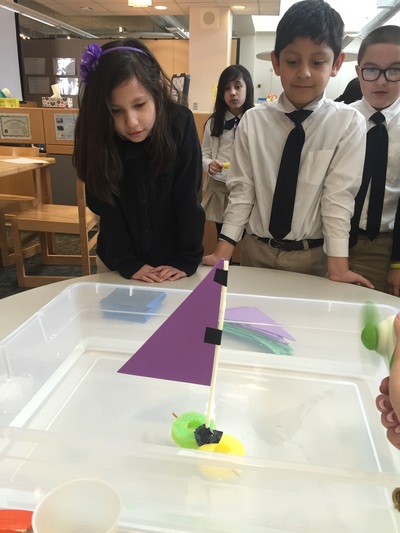Phase THREE
Identify desired results
My main big idea is for students to understand that engineering is all around us, how it relates to our daily lives and how the world is affected by engineers. All three of those are interchangeable and necessary for students to comprehend. This is a relatively big main idea and it can be directed in many ways. I want to keep this pretty open to my STEM students and not necessarily gear them in a specific direction. The enduring value that I hope that they will be able to understand is that everything around them was made by someone with a specific purpose in mind. In addition to just being able to understand just this big concept, I also hope that they will be able to think of the world around them and tinker with it. This idea and the notion of “The World of Wonder” will be the key part of my project. In order to be an engineer or try to put yourself in their shoes, you need to be able to be curious and want to learn why things work and how they work. What I hope to uncover through this year with my students is their interest to the world around them through an engineering lens. In order to be successful, I will implement different components into my daily instructions as well as a semester project that students will continuously be working on and adding new learning.
Determine acceptable evidence (performances of understanding)
Since my big idea is very open, I will have to individually assess students in a lens of their specific project they are working on. In my classroom we have been using the Engineering Design Model, however I will implement the Stanford Design Model in which students will need to empathize, define, ideate, prototype and test their ideas. The overarching project will be a whole semester long “Shark Tank Project”. Thought the projects I will be individually meeting with all of the groups to see their progress, their successes and challenges. I want to serve as a facilitator rather than a teacher telling them what to do. I will be able to track and take observations of the overarching ideas of designing and creating an invention or innovation, and the process that the students are taking in order to create it. In the beginning of the year, I will form a survey using Google Forms so that students to explain their prior knowledge with engineering and what they “think” it is. As part of each class meeting (I see them once a week for an hour), I will embed “The World of Wonder”, where they will have to present whether it is with their group members or individually something that they wondered about and were able to discover. Also, we will do “A Day in History” but to spice it up, I will ask students to keep the events with the engineering context. I also will incorporate tinker time as it is part of my Deep Play topic. Having that creative time, where students will be able to tinker and complete different quick fires will definitely be interesting to see, but will also be full of resources that students will later be able to incorporate in their “Shark Tank Projects”. Since I only will see my students once a week, this is a lot of things I want to “cram” into one hour. However, introducing them to the notion of time and having to be able to be done in a specific time frame will be a great learning experience. At the end of the semester, I will host a Shark Tank Fair, where students will be sharing their projects with other classes as well as parents, and community. I am planning on having some sort of a fair in which students will showcase what they created and how they got there. This will give them more motivation to put 100% effort into something specially knowing that they will have to present it to the public. I will be constantly conferencing with them and facilitating their learning.
Plan learning experience and instruction
Context:
I am a K-8th grade STEM Teacher at Mariano Azuela Elementary School. Our school is a level 1 school in good standing. We are a neighborhood school with almost 1000 students. Our population is predominantly latino, with 96% hispanic students and 87% low income. 11% of our learners are diverse and 25% of students have limited english abilities. With all of that said, this year I will be implementing my Imagine IT with 4th and 5th grade students. I usually see 2 fourth grade classes and 2 fifth grade classes each week. Therefore, I will be able to reach over 100 students. I have a pretty big and open space to use with square tables that can seat 4 students. My middle school curriculum is pretty set, since I am using Project Lead the Way as well as in 7th grade Swift Playground App Programming. Therefore, I have a lot more flexibility and freedom with 4th and 5th graders. The K-3 grade students will be working on their code.org skills as well additional programming softwares. Even thought I am mainly focusing on the 4-5th graders, I do want the program to be also incorporated in all of my grades. Therefore, I will complete tinkering time, day in history, and world of wonder with all of my students, however it might not be as often as with the main study groups. I am lucky to have a whole Laptop Cart available and if necessary I can always request additional computers or another iPad cart. Our school is only 7 years old, therefore we are fortunate to have great technology and fantastic learning conditions.
Content:
The essential part of my big idea will be using the Stanford Design Model as an ongoing process throughout the “Shark Tank Project”. I want the students to have that impeded when they think of engineering and creating things. There are many design models out there. Last year we have been using the Engineering Design Process which is almost identical to the Stanford Design Model. The only difference which I want to point out is that initial step, before you define a problem. I want to spend a good deal of the beginning part of this project to let students understand who they will be designing their inventions or innovations for. If they don’t have the targeted audience in mind and know their needs and wants, their invention does not really have a purpose. I think this might be the hardest part to get them started, but I will defiantly put big emphasis on it.
Pedagogy:
Most of the student work will happen in a group setting in which they will really need to collaborate. I want students to have the “adult/career” experience as they embark on this journey. I try to serve as a facilitator and not a sole teacher. I believe in a classroom where students learn from each other and ask each other for help, before they ask me. Many times, in various projects I don’t know what the right answer is, however I try to steer students in some sort of direction, and most of the time they will be able to find answer or solutions on their own. In addition to group work and collaboration I will be using a ton of different way to reach all of my diverse learners such as: demonstration, tutorials, visualization, inquiry, think-pair-share, role playing, gallery walks, experiments, graphic organizers, quick fires, logging our learning and many others. My whole classroom is going to be based on Project-Based Learning. Also, this year I am part of another grant to focuses on Individualized Learning and personalizing it to each students needs. This is an approach I will be trying to convey as I work with those students as well.
Technology:
I am fortunate enough to have access to a whole laptop cart with all of my students. Also, they are all familiar with Google Classroom and I will depend their understating with Google Apps for Education such as Drive, Docs, Slides and Sheets. This is where they will be taking all of their “notes” and recording their progress. This is going to be great because no student will have an excuse of “leaving” their materials somewhere else. Depending of how students would like to present their final projects, they will be able to research different medium of presenting and use them. In other aspects of the classroom such as the tinker time, I will be providing students with some items they can be creative, which is going to be similar to MSU Urban Stem Summer Fellowship class. I have been able to research few of the Maker’s Movement tools we used in the summer course, and I would like to incorporate that with my class as well.
My main big idea is for students to understand that engineering is all around us, how it relates to our daily lives and how the world is affected by engineers. All three of those are interchangeable and necessary for students to comprehend. This is a relatively big main idea and it can be directed in many ways. I want to keep this pretty open to my STEM students and not necessarily gear them in a specific direction. The enduring value that I hope that they will be able to understand is that everything around them was made by someone with a specific purpose in mind. In addition to just being able to understand just this big concept, I also hope that they will be able to think of the world around them and tinker with it. This idea and the notion of “The World of Wonder” will be the key part of my project. In order to be an engineer or try to put yourself in their shoes, you need to be able to be curious and want to learn why things work and how they work. What I hope to uncover through this year with my students is their interest to the world around them through an engineering lens. In order to be successful, I will implement different components into my daily instructions as well as a semester project that students will continuously be working on and adding new learning.
Determine acceptable evidence (performances of understanding)
Since my big idea is very open, I will have to individually assess students in a lens of their specific project they are working on. In my classroom we have been using the Engineering Design Model, however I will implement the Stanford Design Model in which students will need to empathize, define, ideate, prototype and test their ideas. The overarching project will be a whole semester long “Shark Tank Project”. Thought the projects I will be individually meeting with all of the groups to see their progress, their successes and challenges. I want to serve as a facilitator rather than a teacher telling them what to do. I will be able to track and take observations of the overarching ideas of designing and creating an invention or innovation, and the process that the students are taking in order to create it. In the beginning of the year, I will form a survey using Google Forms so that students to explain their prior knowledge with engineering and what they “think” it is. As part of each class meeting (I see them once a week for an hour), I will embed “The World of Wonder”, where they will have to present whether it is with their group members or individually something that they wondered about and were able to discover. Also, we will do “A Day in History” but to spice it up, I will ask students to keep the events with the engineering context. I also will incorporate tinker time as it is part of my Deep Play topic. Having that creative time, where students will be able to tinker and complete different quick fires will definitely be interesting to see, but will also be full of resources that students will later be able to incorporate in their “Shark Tank Projects”. Since I only will see my students once a week, this is a lot of things I want to “cram” into one hour. However, introducing them to the notion of time and having to be able to be done in a specific time frame will be a great learning experience. At the end of the semester, I will host a Shark Tank Fair, where students will be sharing their projects with other classes as well as parents, and community. I am planning on having some sort of a fair in which students will showcase what they created and how they got there. This will give them more motivation to put 100% effort into something specially knowing that they will have to present it to the public. I will be constantly conferencing with them and facilitating their learning.
Plan learning experience and instruction
Context:
I am a K-8th grade STEM Teacher at Mariano Azuela Elementary School. Our school is a level 1 school in good standing. We are a neighborhood school with almost 1000 students. Our population is predominantly latino, with 96% hispanic students and 87% low income. 11% of our learners are diverse and 25% of students have limited english abilities. With all of that said, this year I will be implementing my Imagine IT with 4th and 5th grade students. I usually see 2 fourth grade classes and 2 fifth grade classes each week. Therefore, I will be able to reach over 100 students. I have a pretty big and open space to use with square tables that can seat 4 students. My middle school curriculum is pretty set, since I am using Project Lead the Way as well as in 7th grade Swift Playground App Programming. Therefore, I have a lot more flexibility and freedom with 4th and 5th graders. The K-3 grade students will be working on their code.org skills as well additional programming softwares. Even thought I am mainly focusing on the 4-5th graders, I do want the program to be also incorporated in all of my grades. Therefore, I will complete tinkering time, day in history, and world of wonder with all of my students, however it might not be as often as with the main study groups. I am lucky to have a whole Laptop Cart available and if necessary I can always request additional computers or another iPad cart. Our school is only 7 years old, therefore we are fortunate to have great technology and fantastic learning conditions.
Content:
The essential part of my big idea will be using the Stanford Design Model as an ongoing process throughout the “Shark Tank Project”. I want the students to have that impeded when they think of engineering and creating things. There are many design models out there. Last year we have been using the Engineering Design Process which is almost identical to the Stanford Design Model. The only difference which I want to point out is that initial step, before you define a problem. I want to spend a good deal of the beginning part of this project to let students understand who they will be designing their inventions or innovations for. If they don’t have the targeted audience in mind and know their needs and wants, their invention does not really have a purpose. I think this might be the hardest part to get them started, but I will defiantly put big emphasis on it.
Pedagogy:
Most of the student work will happen in a group setting in which they will really need to collaborate. I want students to have the “adult/career” experience as they embark on this journey. I try to serve as a facilitator and not a sole teacher. I believe in a classroom where students learn from each other and ask each other for help, before they ask me. Many times, in various projects I don’t know what the right answer is, however I try to steer students in some sort of direction, and most of the time they will be able to find answer or solutions on their own. In addition to group work and collaboration I will be using a ton of different way to reach all of my diverse learners such as: demonstration, tutorials, visualization, inquiry, think-pair-share, role playing, gallery walks, experiments, graphic organizers, quick fires, logging our learning and many others. My whole classroom is going to be based on Project-Based Learning. Also, this year I am part of another grant to focuses on Individualized Learning and personalizing it to each students needs. This is an approach I will be trying to convey as I work with those students as well.
Technology:
I am fortunate enough to have access to a whole laptop cart with all of my students. Also, they are all familiar with Google Classroom and I will depend their understating with Google Apps for Education such as Drive, Docs, Slides and Sheets. This is where they will be taking all of their “notes” and recording their progress. This is going to be great because no student will have an excuse of “leaving” their materials somewhere else. Depending of how students would like to present their final projects, they will be able to research different medium of presenting and use them. In other aspects of the classroom such as the tinker time, I will be providing students with some items they can be creative, which is going to be similar to MSU Urban Stem Summer Fellowship class. I have been able to research few of the Maker’s Movement tools we used in the summer course, and I would like to incorporate that with my class as well.















